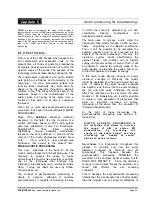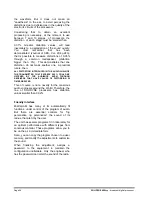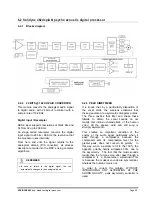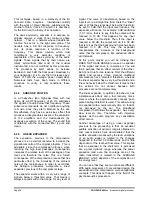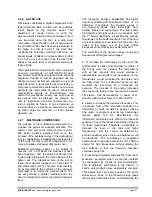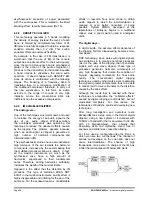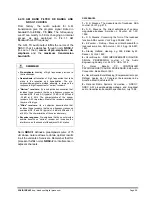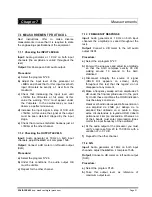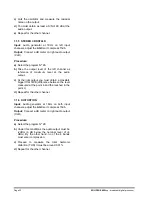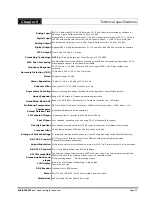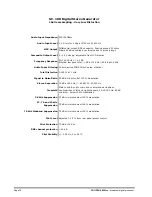
SOLIDYNE 462
dsp - broadcast digital processor
Page 19
So the action of the multiband compressors fits
using the output level control of the AGC.
LOUDNESS BANDS indicators show the
compression degree applied by the multiband
system. Each band has its own indicator.
Usual values for the AGC output are b6
to +12 dB.
TAKE IN MIND
•
How greater the compression degree is, more loudness
has the program on the air. But high compression levels
(greater than 18 dB) can produce a “confused” sound in
certain type of music (hyper-processed, of high density)
and excessive alteration of the timbre (with soloists’
singers or instruments). For this reason it's a critical
adjustment and you must pay special attention to this
control.
4.4.2.2 AGC attack time
The
attack time
is the time that the AGC takes to
reduce its gain when the input signal increases.
Like general rule, it can say that for voices short
times of attack must be used (500 ms); whereas
for music longer times are preferred (3 to 4
seconds).
Note that when the input signal increases quickly,
during the AGC attack time the signal is contained
by the multiband compressor that will act strongly
until the AGC compensates their level. Depending
on the adjustments of the following stages, a too
slow attack of the AGC can cause an excessive
compression of the signal (mainly with voices)
4.4.2.3 AGC recovery time
When the input signal decreases, the AGC begins
to increase their gain to compensate the fall of
level at the input.
Remember that the objective of the AGC is to
assure that the signal reach the processing stages
with a very stable level; independent from the
console's level. The time that takes the AGC in
compensating the gain reduction is called
recovery time.
TIPS
•
In order to process voices, use slow recovery times, so
that the AGC can effectively correct differences in the
program signal. Let us analyze an example: the telephone
line arrives with low level. While the speaker in studies
speaks, the AGC works at certain level; when the caller
speaks, the telephone presents less volume on the air,
and the AGC must act fast to correct this situation;
increasing its gain.
When the speaker returns, the AGC will reduce their gain
again. And it will have to act with very little delay. The
hold threshold will have to be low, to avoid that the AGC
“is hooked” freezing their value during the telephone
communication of previous example.
•
The AGC attack and recovery times must be carefully
defined so that its action is not in evidence. If the attack
time is excessively slow, the action of the AGC could
notice (the level reduction can notice). If the recovery time
is very slow and the attack time is very short, when
somebody shouts (a cough, an outburst of laughter) the
AGC reduces its level abruptly and takes soon in
recovering its level. Then the effect will be similar to
“somebody lowered the volume of the radio”.
•
For music, it agrees that the recovery time be slow. If it’s
fast, the dynamic of the music are completely lost.
4.4.2.4 Hold
This is a gated AGC. For this reason, when the input
signal falls abruptly, the AGC does not compensate its
gain, but that congeals their current value; remaining
in that state until the signal exceeds the “hold”
threshold. Otherwise the AGC would compensate the
input level continuously, increasing the background
noise in the pauses; due to the signal absence the
AGC would increase its possible gain to the
maximum. The Gated AGC solves this disadvantage.
Strictly speaking, AGC value is not congealed; but
that slips slowly towards 0 dB; to avoid that it is
hooked if the signal remains with low level (slope =
0.75 dB each 13 seconds; 4.5 minutes from -15 dB).
On the other hand, you can adjust the HOLD
threshold to conserve part of the dynamic range of the
music. That is to say: if a "forte" passage is followed
by a subtle appearance of an instrument, the AGC will
hold its gain level, giving rise to the contrast of
loudness. When the "piano" passage reaches the
HOLD level, the AGC unhold and begins to increase
their gain according to the recovery time.
4.4.2.5 Expander threshold
Change the expander threshold; from -50 dB to -80
dB in steps of 1 dB. This level is referred to 0VU input
(overload level). The threshold is the point from which
the expander begins to reduce its gain, as signal level
is reduced. The object of the expander is to improve
the signal/noise relation on the air. This is because the



















